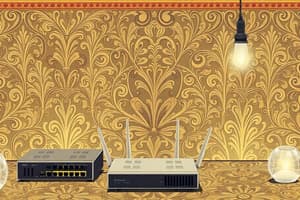Podcast
Questions and Answers
What does the acronym DMZ represent?
What does the acronym DMZ represent?
- Data Management Zone
- Demilitarized Zone (correct)
- Digital Media Zone
- Dynamic Management Zone
What is a Fully Qualified Domain Name (FQDN)?
What is a Fully Qualified Domain Name (FQDN)?
A combination of both the computer name and the domain name.
What is Home Phoneline Networking Alliance (HomePNA) Technology?
What is Home Phoneline Networking Alliance (HomePNA) Technology?
Allows existing home telephone lines to be used for the network media.
What is Internet Connection Firewall (IFC)?
What is Internet Connection Firewall (IFC)?
What does a Proxy Server do?
What does a Proxy Server do?
What is Packet Sniffer?
What is Packet Sniffer?
What is the port number for HTTP?
What is the port number for HTTP?
What is the port number for HTTPS?
What is the port number for HTTPS?
What is the correct port number for FTP?
What is the correct port number for FTP?
What is the difference between port forwarding and single port forwarding?
What is the difference between port forwarding and single port forwarding?
What is the typical assigned IPv4 Address to the host on an ICS?
What is the typical assigned IPv4 Address to the host on an ICS?
What serves as the best way to prevent data loss?
What serves as the best way to prevent data loss?
What path format identifies the server and its share using backslashes?
What path format identifies the server and its share using backslashes?
What are the best ways to secure a router?
What are the best ways to secure a router?
Flashcards are hidden until you start studying
Study Notes
Networking Concepts and Technologies
- Demilitarized Zone (DMZ): A less secure network to allow direct access from the internet while protecting the main network.
- Fully Qualified Domain Name (FQDN): Combines the computer name and domain name to provide an exact address for servers on the internet.
- HomePNA Technology: Utilizes existing telephone lines for networking; requires a HomePNA Adapter for setup.
- HomePNA Adapter: Connects all telephone jacks within a building to create a network.
- Internet Connection Firewall (ICF): Software that blocks unauthorized access to a network.
- Internet Gateway Device Discovery and Control (IGDDC): Mechanism to identify and manage network gateway devices like routers.
Storage and Security
- Network Attached Storage (NAS): Centralized file storage system that requires minimal administrative work.
- Packet Sniffer: Tool for capturing and analyzing data packets traveling over a network.
- Port Forwarding: Router setting that directs incoming traffic on specified ports to designated computers or servers.
- Port Triggering: Monitors outgoing traffic to open specific incoming ports as needed.
Communication and Connectivity
- Powerline Communications (PLC): Technology that turns electrical wiring into a networking medium.
- Proxy Server: Acts as an intermediary for requests from clients seeking resources from other servers.
- Single Port Forwarding: Similar to port forwarding but specifies one IP address rather than multiple.
- Virtual Private Network (VPN): Secures internet data by creating a private tunnel between users and destinations.
Internet Sharing and Hotspot
- Internet Connection Sharing (ICS): Facilitates the sharing of internet connectivity, files, folders, and printers among devices.
- Mobile Hotspot: A portable device enabling multiple users to connect to the internet, functioning off smartphones, tablets, or laptops.
- Wireless Networking: Popular for SOHO environments; requires secure configuration changes and offers two encryption types.
Encryption and Security Practices
- Encryption Types: Advanced Encryption Standard (AES) and Temporal Key Encryption Protocol (TKEP) used for securing wireless networks.
- Dedicated Computer: Specifically used for file storage and sharing, often configured with RAID for reliability.
- Cloud Service Characteristics: Include on-demand self-service, broad network access, resource pooling, rapid elasticity, and measured service.
- Cloud Infrastructure Models: Differentiates between private, public, community, and hybrid cloud settings.
Networking Errors and Troubleshooting
- Network Not Found Reasons: Includes incorrect path, non-existent connection/location, or permission issues.
- Remote Desktop vs. Remote Assistance: Remote Desktop provides full control without the need for user presence, while Remote Assistance helps users with partial access.
- Port Numbers: Remote Desktop (3389), Remote Assistance (3389), HTTP (80), and HTTPS (443).
Configuration Techniques
- Port Forwarding vs. Single Port Forwarding: Port Forwarding allows addresses from the whole local area; Single Port Forwarding focuses on a specific IP.
- Typical IPv4 Address for ICS: Commonly assigned as 192.168.0.1.
- Securing Routers: Essential practices include modifying default credentials, enabling MAC address filtering, and disabling SSID broadcasting.
- Local Group Security Editing Tool: Secpol.msc is the correct utility for managing local group policies.
Studying That Suits You
Use AI to generate personalized quizzes and flashcards to suit your learning preferences.




